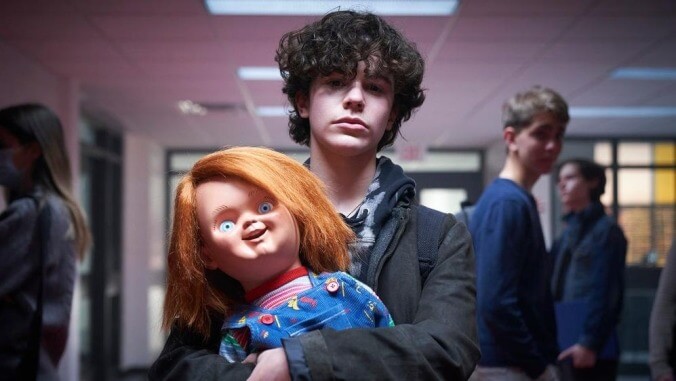Chucky is as foul-mouthed and homicidal as ever in his new Syfy series
Much like the film franchise that spawned it, the new killer-doll series is messy in more ways than one


It may not be the strongest horror franchise in cinematic history, but the Child’s Play series deserves credit for never just repeating itself. Those films, about a smiling plastic doll supernaturally possessed by the soul of serial killer Charles Lee Ray (Brad Dourif), progressed from horror to action to comedy to high camp, before transitioning into haunted-house scares and oddball mystery in its two most recent outings.
But for all the variety in style and tone, there have been two constants: creator Don Mancini, who wrote every installment (and directed three of them), and Chucky himself (voiced by Dourif), who remained a foul-mouthed killer no matter the circumstances. In the jump to cable TV, Mancini and Dourif haven’t softened up the little bastard in the slightest.
Chucky, the new series premiering on Syfy, retains all of the character’s penchant for grotesque kills and juvenile, acidic humor. Before the end of the first episode, the doll is murdering clueless adults, vomiting up liquor, and seizing a microphone to call a roomful of kids and their parents a “bunch of fucking assholes.” By the third episode, the brief opening recaps are preceded by Dourif sneering, “Previously, on fuckin’ Chucky…” Elegant, this show is not.
But again, that’s very much in keeping with the franchise’s big-screen history. Other than the first film, Mancini’s scripts have very much taken place in a slightly heightened reality, where people’s behavior is a little more affected than would be expected, and narrative plausibility takes a backseat to propulsiveness.
In other words, how characters get together in a room with Chucky is less important to the story than watching what happens once they’re there. It can feel a little sloppy at points, but things move along at a nice clip, meaning you’re soon engrossed in the next violently boffo set piece, and considerations about the “but why?” of it all only arise upon subsequent reflection.
The setup is simple, with no prior knowledge of the character required (though familiarity pays off via Easter eggs and winking jokes and references). Jake Wheeler (Zackary Arthur), a lonely 14-year-old misanthrope with outsider-art tendencies, finds an old Good Guy doll at a yard sale (“I’m into vintage,” he explains). Resented by his recently widowed father (Devon Sawa) and bullied by seemingly everyone at school, Jake takes solace in his doll-based creations and in listening to the podcast of the kid he has a crush on, true-crime fanatic Devon Lopez (Björgvin Arnarson).
After his dad drunkenly dismantles his artwork (set to the not-exactly-subtle music cue of Madalen Duke’s “How Villains Are Made”), Jake’s newest doll starts making its presence felt—first in subtle ways, such as dissecting Jake’s biology-class frog in less than scientific fashion, but soon graduating to more homicidal pursuits. And Jake, once he discovers his doll is sentient, finds himself warily drawn to the amoral promise of pain for his enemies. “I’m the one friend you got, Jake,” Chucky says, and he’s not wrong. The first few episodes, then, become a sort of battle for Jake’s soul, albeit with one side benefitting from the ability to gleefully murder anyone of the opposing viewpoint.
Given that it’s a show whose primary draw is watching a sadistic children’s toy stalk and kill people, the series assembles a roster of paper-thin characters ripe for the offing. Jake’s antagonist in the early episodes is Lexy (Alyvia Alyn Lind), the kind of cartoonish teenage tormentor so easy to hate. It’s to the series’ credit that it actually makes the case for why even terrible people don’t deserve to die, while also allowing for the thorny morality of endorsing the right to wish they would.
Lexy spends most of her time making others miserable, especially Jake, so it’s no surprise when Chucky sets his sights on her. But there’s no shortage of potential victims, including brutish bully Oliver (Avery Esteves), Jake’s cousin Junior (Teo Briones), and any number of adults who either treat Jake poorly or simply get in the way of Chucky’s deadly pastime.
Strip away all the enjoyably gory bloodshed, though, and Chucky occasionally struggles to fill the time between its title character’s favorite activity. There are ongoing flashbacks to Charles Lee Ray’s youth, meant to establish his backstory and show how he became a maniac eager to mentor a budding young potential killer like Jake, and while they can be entertaining, they rarely feel necessary.
Similarly, the major beats of the story tend to be telegraphed far in advance, so even when Chucky fails to execute an intended victim, it’s not really a surprise. And throughout, the show’s tone wavers, walking an unsteady line between the surreal camp of the mid-period films like Bride Of Chucky—there’s a school talent show that doesn’t begin to approach the realm of believable—and the clever, grounded smarts of the more recent entries.
When the oddball mix of sensibilities works, Chucky can be daffily entertaining. Lexy sings her little sister to sleep with a lullaby rendition of “Don’t Fear The Reaper” (Chucky describes her as a “vicious little Karen-in-training-wheels”). The local hospital is decorated like something out of a Nicolas Winding Refn film, with neon hot-pink crosses and barely lit corridors. At one point Chucky starts a fire in a teenager’s room that explodes outwards into the house with a giant fireball, only for none of the kids present for a house party to even look up from their headphones and notice.
Does it make much sense? No. But it’s fun to see it play out with a mischievous sense of anything-goes silliness. Mancini and Dourif have been doing this for so long, they seem to have nailed down an understanding of what makes Chucky fun. And when Chucky follows suit, it is too.